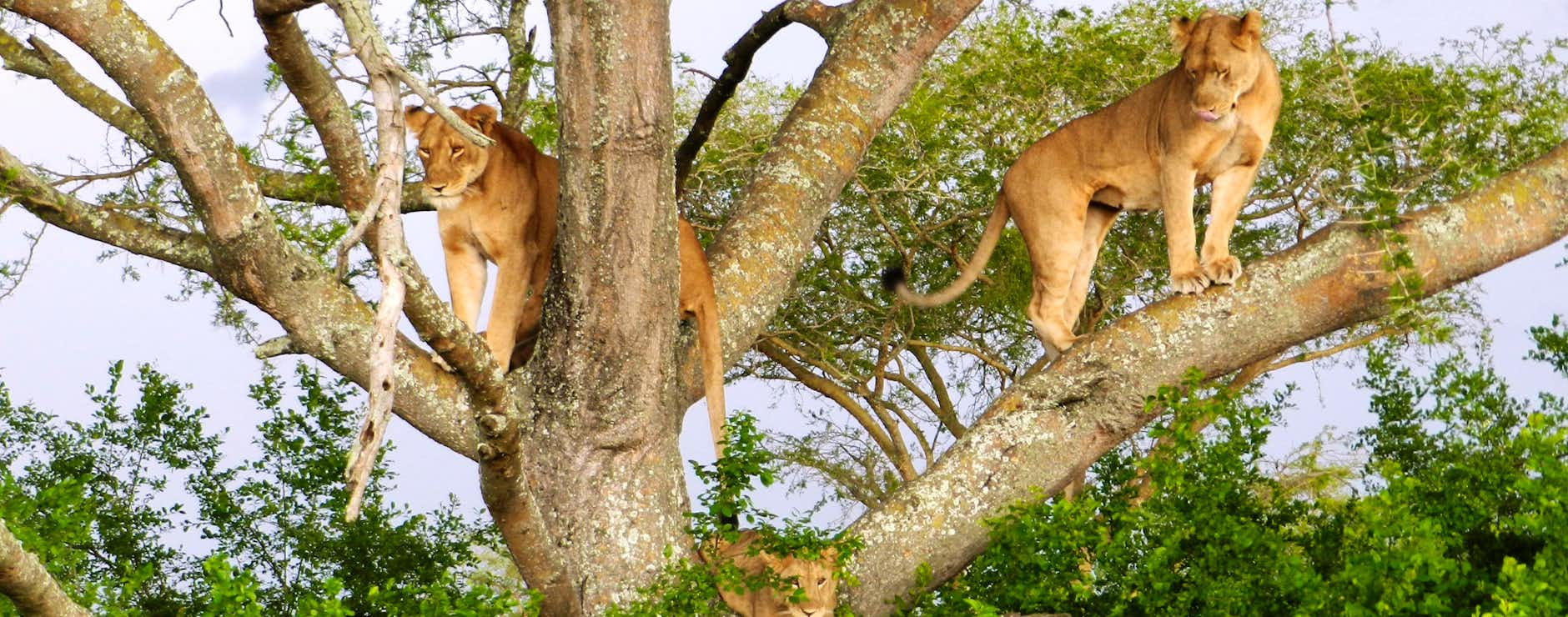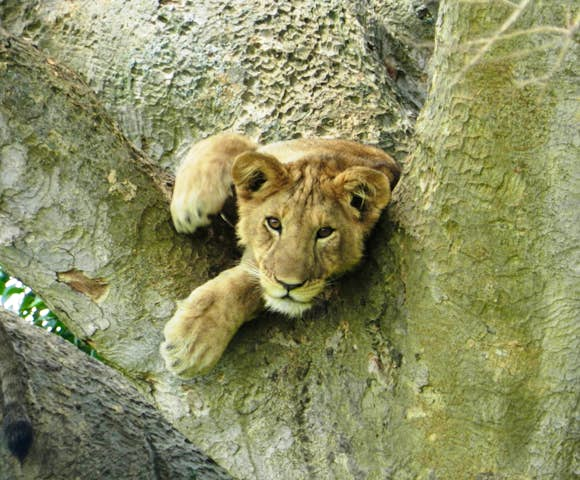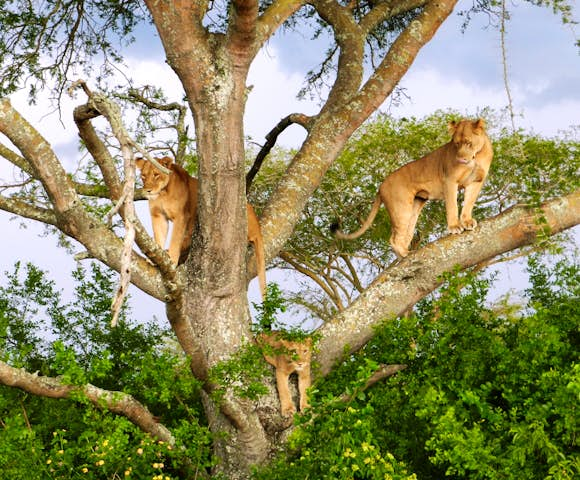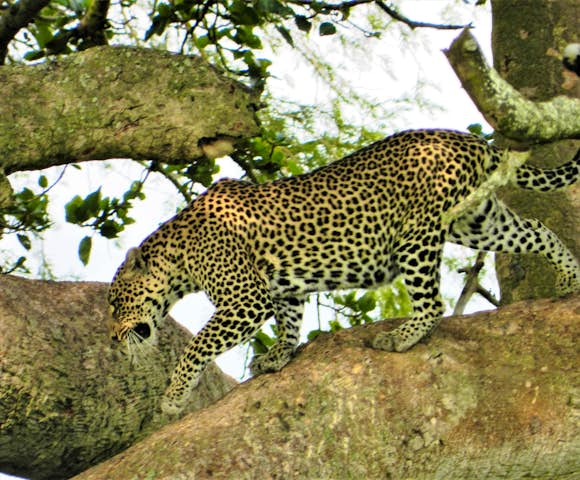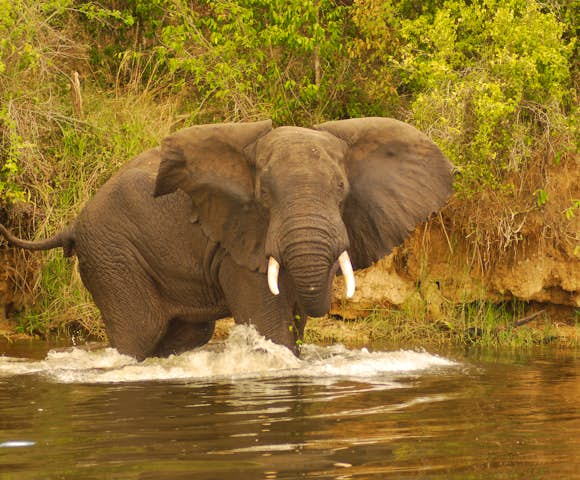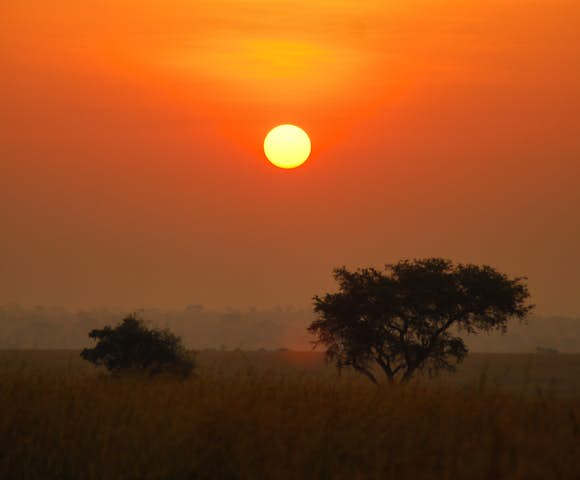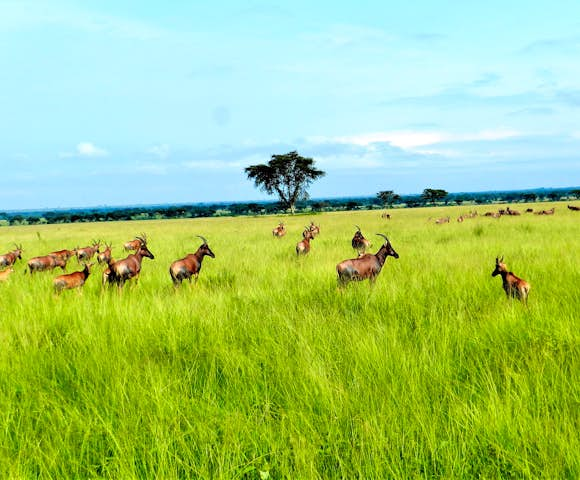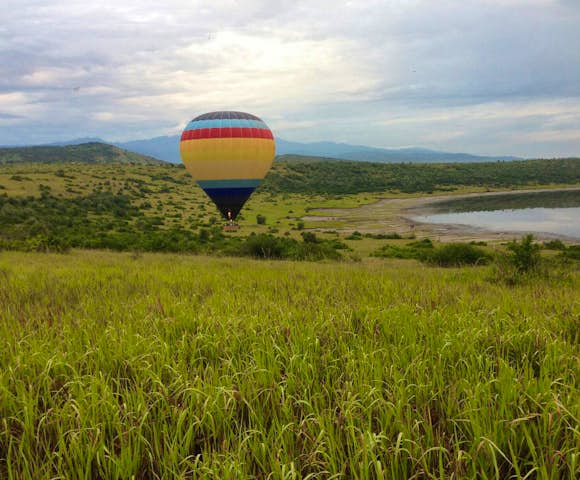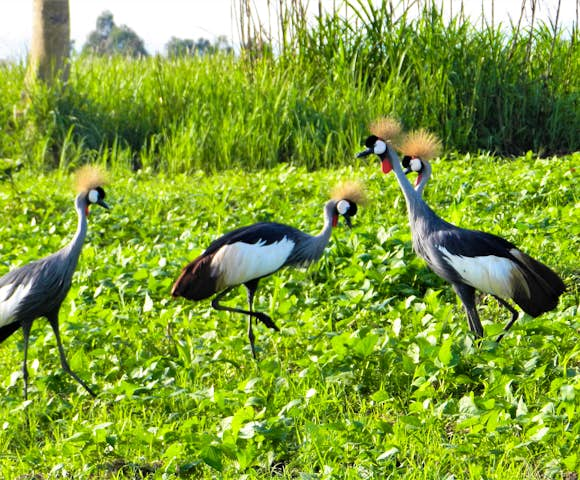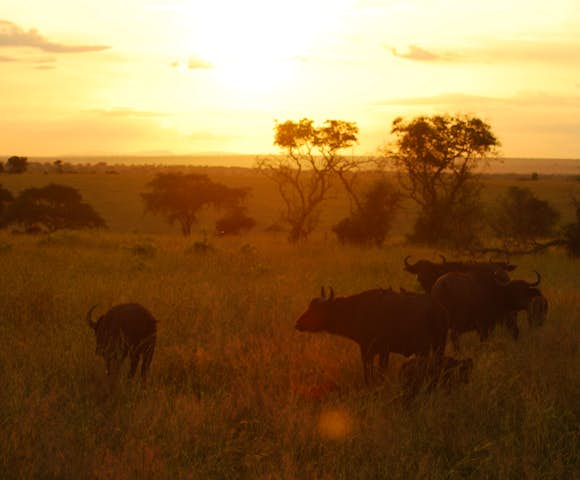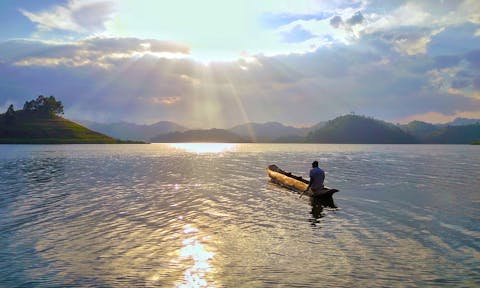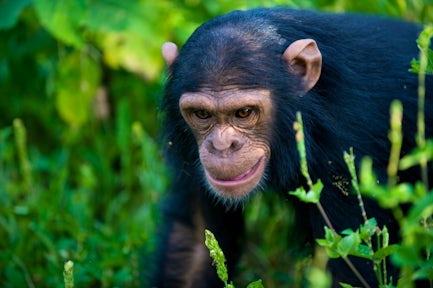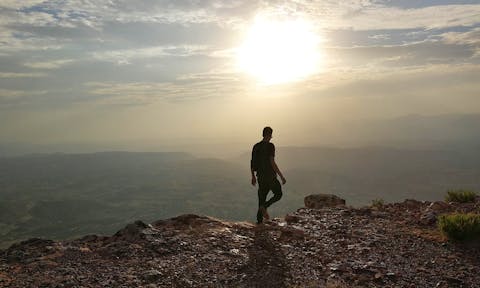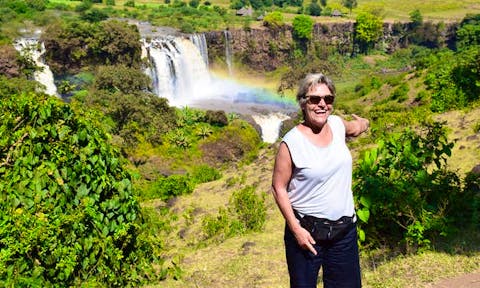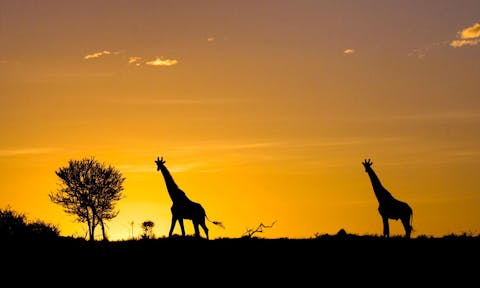Complete Guide to Queen Elizabeth National Park
Contents of our guide
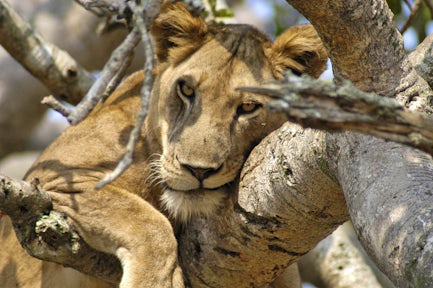
Lioness resting in the branches at Queens.
Popular Trips Including Queens
The tours below showcase just some of what is possible. Use these itineraries as starting points, or to draw inspiration. Then get in touch, and let our expert team help craft the perfect itinerary for you.
5 Reasons to Visit Queen Elizabeth National Park
- Get off-road in search of tree-climbing lions and leopards.
- Find elephants, buffalo, antelopes, and warthogs on the savannah plains.
- Take to the waters and find buffalo, elephants, hippos, crocodiles and pelicans.
- Enjoy the stunning scenery combining dense forests with miles of savannah grasslands.
- Track chimpanzees in the mystical forests of the Kyambura Gorge.
1. Introduction to Queens and what to expect
Introduction
Traditionally overshadowed by the more famous grassland parks of Kenya and Tanzania, Uganda’s savannah parks are unique among safari destinations on the African continent.
Queen Elizabeth National Park (QENP, or Queens) is Uganda's most visited national park and is often paired with Gorilla trekking in Bwindi and/or Chimp trekking in Kibale Forest. The park is famous for its big cats, including tree-climbing lions and leopards. Game drives in will reveal the parks range of big game including elephants, buffalos, antelopes and warthogs.
Boat safaris take you across the Kazinga Channel that links Lakes Edward and George. Here you'll find buffalo and elephant coming down to the shore, pelicans rafting together in the sunshine, and plenty of hippos.
There are over 600 species of recorded birds in Queens, and you can even pair a game drive or boat safari with chimp trekking in the mystical forests of Kyambura Gorge.

QENP is home to over 2500 Elephants.
What to Expect
Queens is attractive for its big cats and beautiful landscapes. It is important not to conflate the ecosystem at Queens with wildlife reserves in such countries as South Africa, Tanzania or Kenya. Queens is not just a wilderness destination, there is a significant human population living in the park and their needs must be managed alongside that of the wildlife.
While Queens has a large big game population, it's the big cats that leave the biggest impression on most travellers. You won't find zebras, rhinos, or giraffes in Queens (but you can find them elsewhere in Uganda including Murchison Falls and Lake Mburo national parks).

Sunrise at QENP, safaris start early for the best sightings.
2. Queen Elizabeth National Park Entry Fees
You must pay a small conservation fee as you enter Queen Elizabeth National Park. The fee is used to support the conservation projects of the Uganda Wildlife Authority.
The fee varies for different groups, so you must remember to take identification. Travellers are required to show their passports, foreign born Ugandans must show a one-year work permit, and Ugandan citizens must show national identification cards.
At the time of writing, the fee for travellers is US$40. Foreign born Ugandans must pay US$30. Ugandan citizens are charged UGX150,000. If you book with us, all of this is taken care of for you.
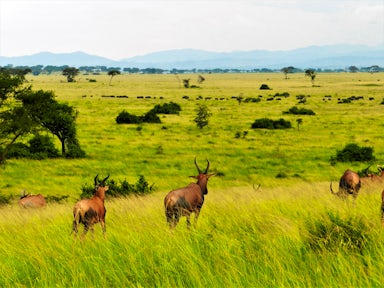
Queen Elizabeth National Park is home to a plethora of wildlife.
3. Wildlife in QENP
With over 95 large mammal species and 600 avian species, Queen Elizabeth National Park is now the most bio-diverse place in Uganda. Its varied habitats include grassland, woodland, moist tropical forest and wetlands, both freshwater rivers and lakes and saline lakes. Of this almost 40,000 hectares is covered by medium-altitude semi-deciduous forest.
Queens has plenty of big game with approximately 5,000 hippos, 2,500 elephants and 10,000 buffalo. Big cats also live here and the Ishasha sector is home to tree-climbing lions. You'll find chimpanzees in Kyamburga Gorge, and extraordinary diversity in bird life.

Lioness resting in the branches at QENP.

Brilliant says
The combination of big cats alongside classic big game is part of what makes Queens such a wonderful safari destination. These animals appear before backdrops of immense beauty; the stunning landscapes the perfect theatre for a unique safari experience.
Large Mammals
Queens has approximately 5,000 hippo, 2,500 elephants and 10,000 buffalo. There are no rhinos, but there is no historical evidence that they ever existed south of the Nile river and north of the Kagera river.
The mammals are found across the plains, woodlands and shorelines, this means you will enjoy great sightings in multiple locations. Photo opportunities will be numerous, but so will the chance to just sit and observe these very special animals in their natural habitat.
Other frequently seen herbivores are warthog, waterbuck, Ugandan kob, topi and the sitatunga antelope of the wetlands around Lake George.

QENP is home to over 2500 Elephants.
Big Cats
For the big cat lovers, there is also plenty to appreciate. Lion are found throughout the park (with the lion research programme providing great access in the Mweya Peninsula area), but they are most famous in the southern Ishasha sector where the population has learnt to climb fig trees to escape the flies.
There are also leopard, civet, genet and serval present. These are all much more elusive, many nocturnal, which makes a sighting all the more special.
The combination of big cats alongside classic big game is part of what makes Queens such a wonderful safari destination. These animals appear before backdrops of immense beauty; the stunning landscapes the perfect theatre for a unique safari experience.

Tree climbing is a behavioural adaptation, rather than a product of evolution.
Primates
In the trees - and foraging in the undergrowth in some cases - reside 10 species of primate. The largest of these are the chimpanzees, found in the hidden forests of Kyambura and the expanse of Maramagambo, and the olive baboons (make sure they don’t try to steal your lunch).
Just as intriguing and worth looking for are the supporting cast of black and white colobus, red colobus, red-tailed monkey, L’Hoest’s monkey, blue monkey, grey-cheeked crested mangabey (Uganda’s only indigenous primate) and the vervet monkey.

Chimps are our closest living relatives, and they share 98.7% of our DNA.
Birding
When any protected area includes a significant range of habitats, you know the birding is going to be incredible. Queens won’t let you down in this respect.
There are over 600 species waiting to be spotted and recorded. While the famous species like the Shoebill stork, pelican and flamingo grab the attention, each habitat is home to a myriad of other superstars - large and small.
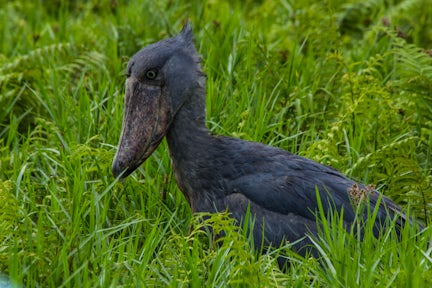
The Mabamba Swamp is home to the famous shoebill stalk.
4. Things to Do
The wealth of flora and fauna in Queens makes it one of the top safari destinations in the country. Pairing a safari experience here with a gorilla trek in Bwindi or chimp trek in Kibale makes for an extraordinary wildlife experience.
All visits to Queens will include a game drive on the Mweya Peninsula and boat cruises along the Kazinga Channel. If you're spending more than 2 nights here, you can visit the chimpanzees in Kyambura Gorge, take a game drive in the Ishasha sector of the park in search for tree-climbing lions, and visit the crater lakes or the salt pans at Katwe.

Sunrise at QENP, safaris start early for the best sightings.
Mweya Peninsula Game Drives
The game drive is the quintessential savannah safari experience. Travelling in four-wheel drive vehicles adapted to provide great visibility through hatch roofs and sliding windows, you will patrol the grasslands with your guide for about 3 hours in the early morning or late afternoon when the animals are at their most active.
Each species has its own ecological niche, or home, and behaviour patterns. When the guide understands these, they can introduce you to the story of the savannah, bringing you closer to its wonderful animals. The bull elephant dosing in the shade of an acacia; the grumpy buffalo, mud encrusted, wallowing in puddles; the lethal lion heading out to hunt as the shadows lengthen.
Kazinga Channel Boat Cruise
There is something very special about watching wildlife from the water. It is peaceful. The sunlight reflecting from the broken surface of the water; the changing expression of the animals as they watch you and consider how to react. With the wind in the right direction, you can often get far closer to larger groups than you can in a vehicle on land.
Boat cruises take place twice a day on the Kazinga Channel, which links Lake Edward and Lake George. Different sized boats are available, but all safaris drift along the shore to Pelican Point. You can expect to see elephant, hippo, buffalo, antelope and a wonderful range of aquatic bird life.
Kyambura Gorge Chimp tracking
Over the centuries, the Kyambura River has cut a deep gorge into the Kichwamba Escarpment. With sides too steep for large herbivores to exploit, dense forest clads the gorge sides providing the perfect habitat for large primates, particularly chimpanzees.
Habituated to human contact, one of Queens’ greatest attractions is spending a few hours tracking our closest relatives through the forest led by a Ugandan Wildlife Authority guide. It really feels like you have entered another world. This is not a ‘zoo experience’: the chances of seeing the chimps are about 60%. It is a real forest quest and a sighting is all the more special because of that.
Marambagambo Forest Walks
For birders and those who love walking far from the normal trails, the Maramagambo Forest is the perfect place to spend half or even a full day.
Sheltered from the hot sun by the dense canopy, you can explore the shadows, discovering species not seen on the open plains, stumble across hidden crater lakes and marvel at the sheer mass of life found within a bat cave.
Don’t go too close: snakes wait in the rocks of the cave floor to catch the bats that fall from their perches, dislodged by stronger, more frantic, neighbours.

Ishasha Plains Game Drives
Human history is fascinating, but wilderness is compelling, pulling at something deep within us. If you feel that pull, then stay in the Ishasha sector. But don’t climb the fig trees: you may be jostling with a lion or two for the best branches.
Ishasha is an area of open woodland in the south-west of the park on the way to Bwindi Impenetrable Forest. It is explored by game drives and, even though a couple of lodges have recently opened in the sector, it receives relatively few visitors. This makes for delightfully private game drives and sundowners to remember.
Crater Lakes Drives
There are 72 craters of different sizes scattered throughout the park, evidence of the areas tumultuous volcanic history. Many of these are clustered in the north of the park making for a fascinating half day drive when the view and geologic record is the focus rather than the wildlife.
It's humbling to think back to the formation of these craters, dozens of impressions on the Earth's crust, becoming enveloped by flora and fauna over the ensuing millions of years. The violent and fiery past of the craters abruptly contrast to the green, forested oasis of life that exists there now.

Lush greenery all around
Katwe Salt Pans Visit
To understand the human history of the park, visit the salt pans at Katwe. You will marvel at the fortitude of the people who work in this most astringent of environments. They practice a trade with deep historical roots that once formed the wealth of a powerful kingdom.
Wander around the pans, observing the traditional techniques applied in the shadow of an abandoned processing plant that proved unable to handle the high levels of salinity found at Katwe. It is hot here. The sun’s glare is harsh. You won’t stay long, but it is well worth the visit.
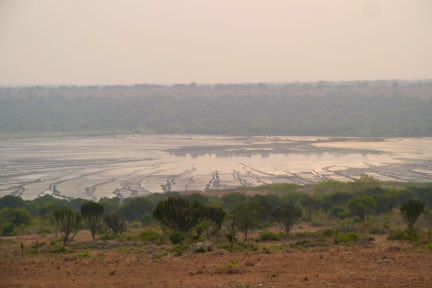
5. When to Visit
The whole concept of ‘the best time to visit’ doesn’t really apply to Uganda. The country is equatorial and so receives rainfall much of the year through. Plus, weather patterns seem to be changing, making rigid seasonality outdated. So pack a waterproof and get ready for anything.
Having said that, it is generally drier from June to early October and again in December through to early March. Higher rainfall is normally experienced in October and November and March through to the end of May. The heaviest rainfall occurring in April, traditionally May as well, but this has been relatively dry in recent years.
6. A typical safari at Queens
Queens is often visited before or after gorilla trekking in Bwindi or chimp trekking in Kibale Forest. It's a 2-3 hour drive from each of these destinations. Typically, you will typically arrive at Queens in the mid to late afternoon. The first day is spent relaxing around the lodge - Elephant Plains Lodge in the northeast escarpment is a popular choice - as you prepare for an early morning start for safari the following day.
A typical 3 day safari at Queens
-
Day 1
After an early breakfast, enjoy a game drive with a difference. Join a lion tracking excursion and become a researcher for the morning as you learn to use telemetry to find the different lion prides who roam the savannah of Queen Elizabeth National Park. There is no better way to find and photograph lions in all of Uganda.
During the drive, the guides and researchers will discuss human-animal conflict in communities around the park, veterinary issues within the park, and lion family dynamics as part of a very in-depth game drive.
In the afternoon, take to the water for a scenic boat cruise along the Kazinga Channel, a 33 kilometre long natural and pre-historic canal that joins Lake Edward and Lake George. Formed by tectonic activity millions of years ago during the formation of the rift valleys, the canal, 2-3 kilometres at its widest, is now the most dominant feature of Queen Elizabeth National Park.
You are almost always guaranteed excellent wildlife sightings including large schools of hippos, Nile crocodiles, wallowing buffaloes on its reedy banks, elephants, multitudes of birds including many endemics as well as numerous other plains game that come to drink at its water’s edge all day long.
-
Day 2
Out again for a morning game drive. After lunch, you will depart the northern part of Queens and drive to the southern section of in search of the tree climbing lions. It is a beautiful route with the Rwenzori Mountains on your right side and the green valley on the left. Game drive through the afternoon until arriving at your lodge in time for sundowners.
-
Day 3
Morning and afternoon game drive in Ishasha in search of the tree climbing lions. Visitor numbers are much lower in this section of the park than in the north, which makes the game drives that bit more memorable.
In the afternoon visit the nearby Agatha's community project to learn real stories of how the community in Ishasha is devising ways to pull themselves out of poverty, guests will participate in preparing a meal of millet Pap/porridge from scratch.

Brilliant says
Queens is a very modern safari destination where the needs of a long-established human population are managed alongside those of the wildlife protected by the park.
7. How long to spend in Queens?
Most visit to Queens last a minimum of two nights. You will want at least two full days to explore the park for game drives and boat safaris. The day you arrive at Queens will be spent at leisure as you won't arrive early enough to begin safari immediately.
If you have more time available, you can spend up to four nights in the park and visit the chimpanzees in Kyambura Gorge, take a game drive in the Ishasha sector of the park in search for tree-climbing lions, and visit the crater lakes or the salt pans at Katwe.

Over 2500 Elephants roam in Queens.
8. Getting There
The park is easily accessible, both as a single destination and connectable as part of a longer itinerary.
The park's proximity to Bwindi and Kibale make it a popular pairing with gorilla or chimp trekking. If you're on a longer itinerary, you will almost certainly stop by Queens as it provides the best lion sightings anywhere in Uganda.
Roads in Uganda are improving quickly, but you still need to allow the best part of a day to drive from Entebbe to Queens. The journey from Kibale Forest and the Fort Portal area takes about 3 hours. Driving from the Mweya Peninsula to Buhoma, northern Bwindi, takes about 4 hours.
Alternatively, scheduled light aircraft flights link Queens to Entebbe and some other locations in Uganda. The flight takes between 60 and 120 minutes depending on the routing used.

9. Places to Stay
There are 5 main sectors of Queen Elizabeth National Park:
- The Northeast Escarpment
- Kyambura Gorge
- Ishasha sector
- Mweya Peninsula
- Rift Valley Escarpment.
Each has different accommodation options available. The varied topography of Queens means that there is a good range of properties available and you'll have no problem finding solitude or a great view.
Brilliant doesn’t use all the properties available, instead we support those that have proven to send back a long line of happy customers.
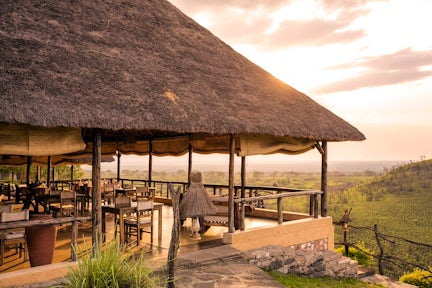
At the edge of Queen Elizabeth Park, Kyambura Lodge overlooks the plains.
In the Northeast Escarpment
The escarpment to the northeast of the park provides panoramic views of the grassland across to Lake George and easy access to the Mweya Peninsula; it is home to Elephant Plains Lodge, one of the newest properties in the park.
Elephant Plains has a bar and lounge overlooking a pool and private cottages dispersed around the main compound, the views over the park are stunning and you can often spot wildlife wandering through the plains from your cottage veranda.
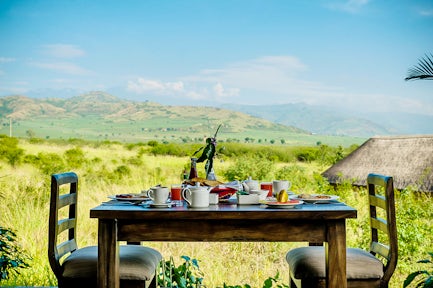
Dinner with a view
In Kyambura Gorge
The ridge leads round to Kyambura Gorge, a natural rent in the otherwise flat plains, cut by water and thickly forested. The elegant Kyambura Gorge Lodge is the closest property to the gorge and so is perfectly located to provide a luxurious base for chimp trekking, plus game drives and boat safaris in the heart of the park.
Stunning views of the savannah plains and the gorge, great food and drink selection, and exceptional service. Kyambura Gorge is consolidating itself as one of the best lodging options in Uganda.
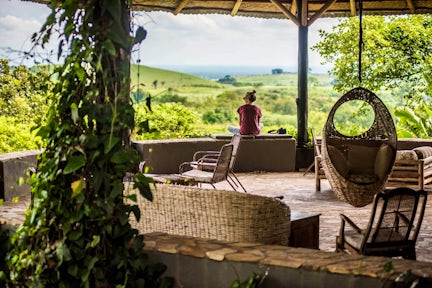
Kyambura Lodge is a luxe base for Chimp trekking and game drives.
In the Ishasha Sector
In the south-west of the park, the Ishasha sector is the place for those who value the wilderness experience. Although new lodges are being constructed, it is still the quietest area where the human footprint is slight.
The established favourite here is Ishasha Wilderness Camp, a superbly comfortable, subtly developed, camp on the banks of the Ishasha River, the natural border between Uganda and the Democratic Republic of Congo.
Ishasha Wilderness Camp is one of the few true tented camp experiences in Uganda.
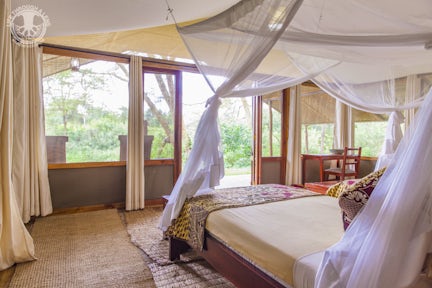
In the Mweya Peninsula
The Mweya Peninsula juts into the Kazinga Channel. The views from here are epic as the distant grasslands seem to merge into the lakes stretching beyond. Mweya Safari Lodge occupies prime position here.
A large hotel, it is a heritage property that began life as a government property over 30 years ago. A stay here is not as intimate as at other smaller properties, but you can’t beat the central location. Perfect for access to Kazinga Channel boat cruises.
In the Rift Valley Escarpment
The Rift Valley Escarpment extends to the south-east of the park. There, on a ridge rising dramatically above the plains, 16 kilometres from the Katunguru Gate of the park, you will find a number of other small lodges all situated to take advantage of the views and the wonderful sunsets.
Katara Lodge is one of our favourites here. The lodge feels borne from the wilderness it sits in, with bamboo architecture and wooden beams holding up the thatched roofs under which you can gaze endlessly at the sweeping savannah in front of you.
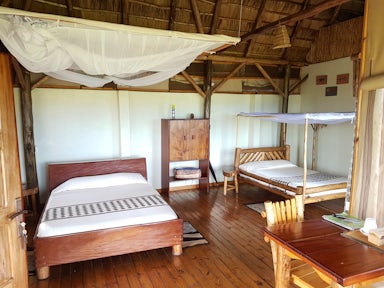
10. About Queen Elizabeth National Park
A Snapshot
Queen Elizabeth National Park is a 1,978 square kilometre UNESCO Biosphere Reserve, an area of global scientific importance 350 kilometres from Kampala. A Biosphere Reserve recognises and balances the needs of long-standing human communities and wildlife populations, seeking to achieve sustainable ways to manage and protect the local environment.
Continuous with the Parc National des Virunga in the neighbouring DRC, forming the Greater Virunga Landscape, Queens is part of one of the largest protected areas in East Africa.
With the foothills of the Rwenzori Mountains as a backdrop on a clear day, Queens is made up of the grasslands of the Mweya Peninsula and Ishasha, the crater lakes, the forests of Maramagambo and secret Kyambura, and the great shimmering stretch of the Kazinga Channel.
The Park lies in the Western Rift Valley, the East African developing divergent plate boundary that formed in the Miocene Period about 25 million years ago. The escarpment of the Western (or Albertine) Rift forms part of the eastern border of the park.
The Park is roughly split north to south by the 32 kilometre long Kazinga Channel that connects Lake Edward to Lake George. Eruptions in the mid-Pleistocene formed crater lakes which now provide another distinct landscape in the north and north-east of the park. The most famous of these lakes, Katwe, has extensive salt deposits which have been mined for centuries. The Katwe explosion craters are the Park’s highest point at 1,350 metres above sea level; Lake Edward, at 910 metres, is the lowest point.
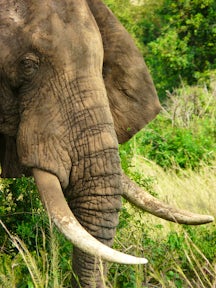
Conservation success story
The history of Queen Elizabeth National Park is very different to the majority of African protected areas in that human habitation can be traced back on the Mweya Peninsula over 50,000 years. Even up until the beginning of the 20th century, the area was used for cattle production by first the WaSongora people and then the WaGanda people.
This changed when first rinderpest and then trypanosomiasis hit the area, devastating livestock and forcing an evacuation of the area from 1913-14. Although people returned throughout the ‘20s, trypanosomiasis levels rose, forcing a second evacuation and keeping human population levels low as the century progressed. Into this void came the wildlife.
By the 1960s, the new park had one of the highest large mammal population densities in Africa. This suffered in the 1970s and 1980s due to systematic poaching by the army and civil war. However, significant numbers of animals were able to cross into the neighbouring Congo, which was at that time peaceful. So when order returned to Uganda, the populations of large mammals were able to re-establish swiftly.
It is thought now that numbers are back close to the levels seen in the 1960s.

The handsome francolin is a large terrestrial forest bird.
11. Popular Trips Including Queen Elizabeth National Park
The tours below showcase just some of what is possible. Use these itineraries as starting points, or to draw inspiration. Then get in touch, and let our expert team help craft the perfect itinerary for you.
Thinking about visiting Uganda?
Listen
We'll spend some time listening to your aspirations, then discuss the kind of experience that might suit you.
Match
Next we'll discuss the options, shortlist the best trips for you and present you our impartial recommendations.
Reserve
We'll place a 24 hour hold on your preferred option - without obligation - whilst we talk through the details.
Get in touch and we can help you understand your options, design an itinerary that's right for you, and then get you set up and ready to go.
+1 315 645 2889

